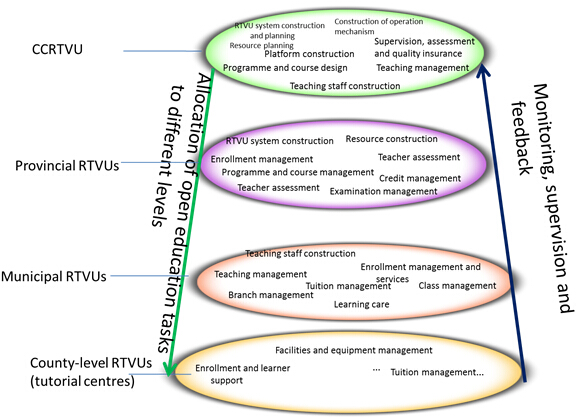Page 2 of 6

Figure 1 The Bureaucratic Management System of the RTVU System
2. The construction of the OUC operating system focuses on changing the bureaucratic management structure and strengthening the cohesion and innovation of the system.
Although the “bureaucratic management” over the past 30 years has ensured the stability and efficiency of the system and boosted resource sharing, the system lacks flexibility, adaptability, and a humanized basis. In the face of economic and social development, increasingly complex educational needs and deepening reform of the educational system, the RTVU system’s single mode of degree education has been confronted with unprecedented challenges. The integration of the RTVUs at the grass-roots level in various provinces into other educational institutions is of particular importance. Studies show that more than two-thirds of the RTVUs at the grass-roots level in the provinces of Shangdong and Yunnan have reduced their status as independent legal entities to affiliates of other educational institutions. The National Outline for Medium and Long-term Education Reform and Development (2010-2020) has drawn attention to the need to run open universities effectively. Furthermore, the inauguration of the OUC, Beijing Open University, Shanghai Open University, Guangdong Open University, Jiangsu Open University and Yunnan Open University marks a new stage in the pilot construction of China’s open universities. At a time when the RTVU system is faced with great changes at both the macro (e.g. national policy) and micro (e.g. maintaining cohesion during system construction) levels, how to reset and realize the function of the system in running the school seems particularly important. When the construction of the RTVU system once again becomes a new development objective, both the central and local universities should be active in finding solutions to problems. At the same time, methods are being sought to carry out a new round of exploration and practical innovation based on the RTVU system at a higher level, in order to better serve lifelong learning and the construction of a learning society. These are the major issues confronting the national RTVU system and the primary basis for the construction of the OUC operating system.
II. An analysis of the features of the construction of the OUC operating system based on self-organization theory
1. The definition and basic concept of self-organization theory
Organization refers to an orderly structure or the formation of an orderly structure within a system. According to the German theoretical physicist Hermann Haken, when seen from the perspective of organizational evolution, organization can be divided into two types: hetero-organization and self-organization. A hetero-organization is an organizational system formed with the aid of external instruction. On the other hand, a self-organization is a spontaneously formed orderly structure based on shared responsibility and coordination according to some rule of mutual understanding without external instruction. Self-organization theory studies the complex phenomena of human society and the natural world and explores the basic laws for the formation and evolution of these complex phenomena. Subjects in the study include issues concerning the formation and development mechanisms of the complex self-organization systems of life and social system, namely, how the system evolves from disorder to order under certain conditions. The core theoretical concepts of self-organization theory are dissipative structure and synergetics. The former refers to solving environmental conditions for the advent of self-organization, while the latter refers to solving the problems of dynamics for self-organization. It is generally thought that the basic conditions for the formation of self-organization are an open system, imbalance, nonlinear interaction and fluctuation. The stronger a system’s self-organization functions, the greater its capacity to maintain and produce new functions[4]. With the advance of the study of complexity science, self-organization has developed a higher objective: the complex adaptive system. The Santa Fe Institute (SFI), the modern centre for the study of complexity theory, believes that a complex adaptive system “obtains information on the environment and its interaction with the environment, summarizes the regularity of the obtained information, refines a kind of ‘scheme’ or model from the regularity, and finally takes corresponding actions based on the scheme in practice.”[5] It is thus clear that a system of dynamic self-organization emerges as the conscious subject adapts to the environment.